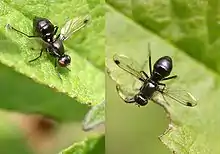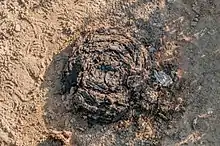Sepsis thoracica
Sepsis thoracica, more commonly known as the black scavenger fly, a species of fly from the genus Sepsis and the family Sepsidae. It was discovered by Robineau-Desvoidy in 1830. It resembles a small flying ant. The fly is most commonly found inhabiting cow dung.
| Sepsis thoracica | |
|---|---|
 | |
| Scientific classification | |
| Kingdom: | |
| Phylum: | |
| Class: | |
| Order: | |
| Section: | |
| Family: | |
| Subfamily: | Sepsinae |
| Genus: | |
| Species: | S. thoracica |
| Binomial name | |
| Sepsis thoracica (Robineau-Desvoidy, 1830) | |
Sepsis thoracica shows positive directional selection in body size that corresponds with negative selection of melanism. In addition, body size and coloration are coupled via gene regulation. A hypothesized mechanism is through the enzyme phenoloxidase.
Description
Sepsis thoracica is a relatively small fly (often described as ant-like), averaging 5 mm in length and 0.75 mm in width.[1] They have a rounded head with compound eyes. The last segment of the body contains short, silver hair. Their wings are mostly transparent with dark spots towards the ends. The developmental temperature influences their body size, in accordance with the temperature-size rule.[2] Females are completely black and smaller than males.
Male polymorphism
Males can be either black or amber, a coloration that is usually only observed in more tropical species. S. thoracica is the only fly of the genus Sepsis to exhibit this male polymorphism in relation to size. While males can be a spectrum of colors between black and amber, most are usually one of the extremes.[2][3]
Thermal radiation, which is the long-waves emitted by the atmosphere, is important in the development of S. thoracica because the
Distribution
Sepsis thoracia has a wide distribution. It is mainly found in Europe, particularly in the United Kingdom, extending as far north as Denmark and southern Sweden. It is also in Afrotropical and Australasian regions. It has most recently been found in Vietnam and South Korea. It is mostly dispersed near the coasts and at high elevations in mountain ranges.[4]
Habitat

Sepsis thoracia is a dung fly and prefers cow dung and buffalo dung, especially in human-managed agricultural grasslands.[5] However, the flies typically avoid horse dung.[6] They are a tropical and subtropical species that are extremely heliophilic, or attracted to sun.[7] They are most active between the months of July and October.
Life history
Females deposit their eggs into the dung.[5] The larvae are not able to escape this during development and thus the flies only leave when they are adults. The larvae are amphipneustic, meaning that both their first and last spiracles are functional. The two spiracle pairs of the respiratory system are on the prothorax and the posterior of the abdomen.[1] The developmental time of the larvae is four days and five hours, optimally at a temperature of 26-28 °C. In cow dung, 15–22 days marks the total developmental time. These flies enter dormancy in response to dropping temperatures.[4]
Food resources
They spend a considerable amount of their life foraging for nectar and their insect prey, Sc. stercoraria. They feed on dung for protein and nectar for carbohydrates. While they are found to mostly feed on cow dung, they have been shown to feed on horse dung if it is available in their area.[8] The competitor density they face largely depends on the amount of eggs laid in the dung pat from which they emerged.[4] They don’t face much outside species competition.
Mating
Sexual selection
Sepsis thoracica has shown a strong, positive directional selection on body size that coincides with a strong negative selection of melanism. The dichotomous coloration is thought to have evolved as a way to indicate their size and fitness.[8] The purity of amber color relating to size was most likely maintained due to the cost it retains from reduced immunity. This causes a trait threshold, where only the largest individuals in a competitive environment can afford to be amber. The larger, amber-colored males are favored by females over the small, black males. However, black males have greater success than mid-sized, mid-toned males.[3][8] Mating practices do not differ between males of different colors, but reproductive fitness is higher in the larger, amber males,
Copulation
Sepsis thoracica does not exhibit any pre or post-copulatory guarding in Europe, but it does have pre-copulatory guarding in more tropical areas, such as Zimbabwe.[9] This mating behavior occurred on the dung pat, with males scrambling and competing for the exceedingly rare single females. Male rejection and struggle behavior does occur. When a mate is found, copulations take place in the nearby vegetation. S. thoracica has relatively long copulation and guarding durations, similar to S. cynipsea.[9]
Enemies
Sepsis thoracica faces mostly generalist predators in their pastoral habitat.[8] Vertebrates include birds, Lacerta lizards, and amphibians when close enough to ponds. The main predators are terrestrial invertebrates, like spiders and insects, primarily other flies and wasps. When dealing with vertebrate predators, black S. thoracica have a greater advantage over amber-colored flies. When encountering an invertebrate predator, being larger is more advantageous than being black. Since S. thoracica is most likely to encounter an invertebrate predator, size is the best defense mechanism for S. thoracica.
Genetics
Body size and coloration are coupled together, likely via gene regulation. They have been shown to be functionally linked through the enzyme phenoloxidase, which works in the phenoloxidase system.[2][10] This system is the main immunological defense system of S. thoracica. The reduction in melanin conforms with lower amounts of phenoloxidase, which compromises the immune system. This causes larger, amber individuals to be immunocompromised.[10] This polymorphism is seen in related species such as Saltella sphondylii, implying a more general evolutionary relevance.[2]
Physiology
Thermal radiation
Thermal radiation, which is the long-waves emitted by the atmosphere, is important in the development of S. thoracica because the dung on which the flies eat absorbs most of the short-wave radiation from the sun because of its dark color. This causes the dung to emit long-wave radiation which is absorbed by the flies. The amount of long-wave absorbance does not differ based on the amount of melanism because it’s out of melanin’s spectrum; consequently, absorption relies only on size. Larger individuals thus absorb the most radiation but also have a lower heat-exchange rate with the environment due to its low surface volume ratio. Larger flies retain more heat and are more prone to overheating. This can be compensated by lower melanism, which absorbs the short-wave radiation. The reduction in short-wave radiation can negate the effects of the long-wave radiation, allowing both amber and black colored S. thoracica to have relatively similar temperatures.[2]
UV radiation
Protection from UV radiation is also exploited by the dichotomous nature of the males. Black flies have a high amount of melanin, which they use to directly protect itself from UV damage. Amber flies invest in their cuticle, which becomes thicker with increased size.[2] Thus, beyond a threshold, UV radiation will have little to no penetrance. This is an importance defense mechanism since UV radiation can lead to unwanted genetic mutations.
References
- Meier, Rudolf (January 1996). "Larval morphology of the Sepsidae (Diptera: Sciomyzoidea), with a cladistic analysis using adult and larval characters". Bulletin of the American Museum of Natural History. 228: 3–147.
- Busso, Juan Pablo; Blanckenhorn, Wolf U. (March 2018). "Climatic factors shape plastic trade-offs in the polyphenic black scavenger fly Sepsis thoracica (Diptera: Sepsidae)". Journal of Biogeography. 45 (3): 593–603. doi:10.1111/jbi.13140. ISSN 1365-2699.
- Busso, Juan Pablo; Blanckenhorn, Wolf U. (2018-05-09). "Disruptive sexual selection on male body size in the polyphenic black scavenger fly Sepsis thoracica". Behavioral Ecology. 29 (3): 769–777. doi:10.1093/beheco/ary038. ISSN 1045-2249.
- Zeender, Valérian; Roy, Jeannine; Wegmann, Alexandra; Schäfer, Martin A.; Gourgoulianni, Natalia; Blanckenhorn, Wolf U.; Rohner, Patrick T. (April 2019). "Comparative reproductive dormancy differentiation in European black scavenger flies (Diptera: Sepsidae)". Oecologia. 189 (4): 905–917. Bibcode:2019Oecol.189..905Z. doi:10.1007/s00442-019-04378-0. ISSN 1432-1939. PMID 30877577.
- Bai, M. Geetha; Sankaran, T. (1977-06-01). "Parasites, predators and other arthropods associated with Musca domestica and other flies breeding in bovine manure". Entomophaga. 22 (2): 163–167. doi:10.1007/BF02377838. ISSN 1573-8248.
- Hafez, M. (1948). "Ecological and Biological Observations on Somi3 Copro-Phagous Sepsidae (diptera)". Proceedings of the Royal Entomological Society of London, Series A. 23 (10–12): 99–104. doi:10.1111/j.1365-3032.1948.tb00608.x. ISSN 1365-3032.
- Pont, Adrian (1987). Provisional Atlas of the Sepsidae (Diptera) of the British Isles (PDF). British Records Centre. ISBN 1-870393-00-7. Retrieved 2019-10-31.
- Busso, Juan Pablo; Blanckenhorn, Wolf U. (July–August 2018). "Viability selection by invertebrate predators in the polyphenic black scavenger fly Sepsis thoracica". Behavioral Ecology. 29 (4): 992–1000. doi:10.1093/beheco/ary039.
- Blanckenhorn, Wolf U.; Cozzi, Gabriele; Jäggli, Gregory; Busso, Juan Pablo (2019-05-08). "Size- and sex-specific predation on dung flies by amphibian and arthropod predators – size match matters". bioRxiv: 631549. doi:10.1101/631549.
- Busso, Juan P.; Blanckenhorn, Wolf U.; González‐Tokman, Daniel (2017). "Healthier or bigger? Trade-off mediating male dimorphism in the black scavenger fly Sepsis thoracica (Diptera: Sepsidae)". Ecological Entomology. 42 (4): 517–525. doi:10.1111/een.12413. ISSN 1365-2311.
_-_Kitchener%252C_Ontario_02.jpg.webp)